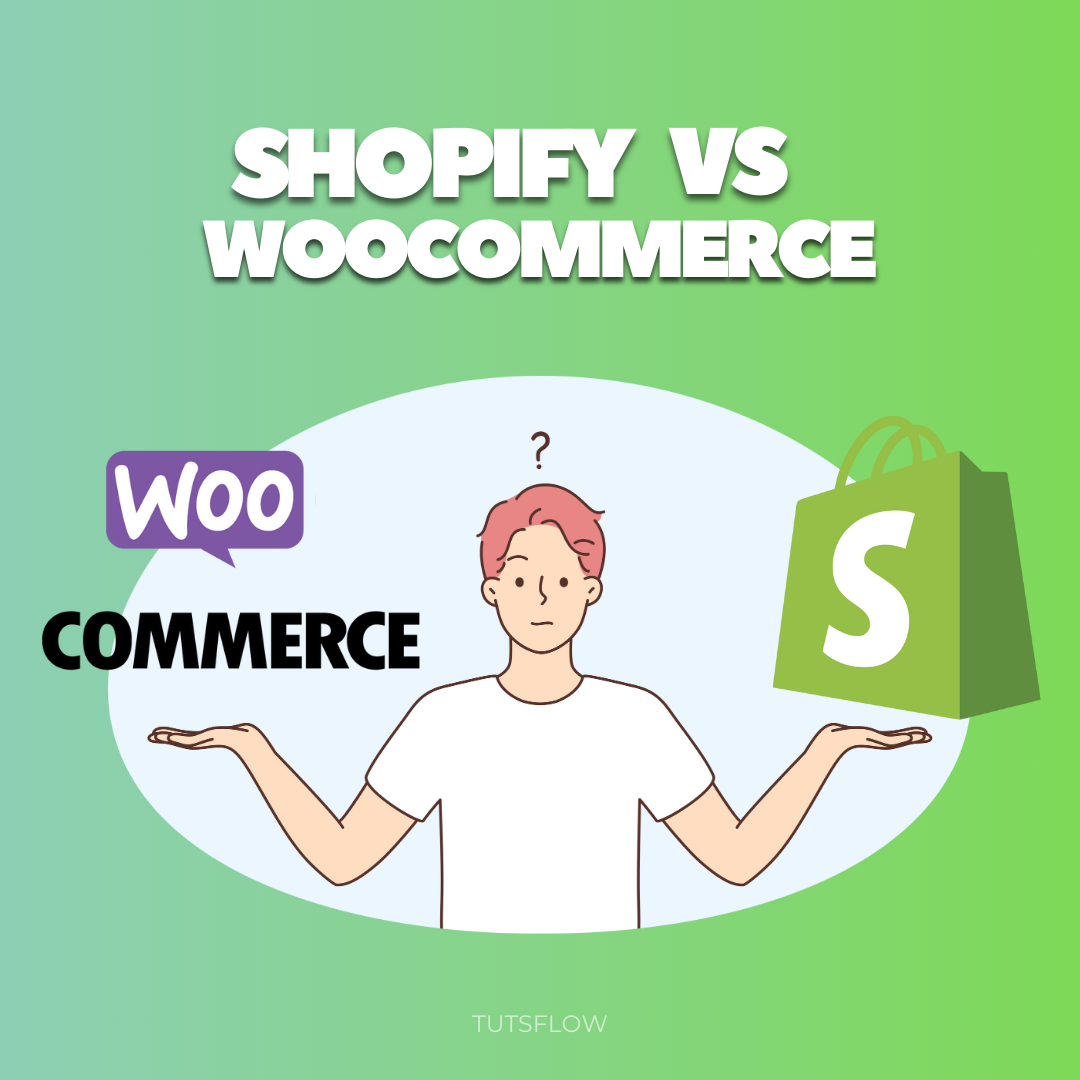When it comes to starting an online business, selecting the correct eCommerce platform is one of the most important decisions you will make. So, Shopify vs WooCommerce? Hold on, we will get through it by the end of this blog.
These are two of the most widely used eCommerce platforms. Both systems offer distinct advantages, catering to various company requirements and customer preferences. However, picking between Shopify and WooCommerce may be difficult, especially if you are new to eCommerce or want to move from a different platform.
In this blog, we aim to provide a comprehensive comparison of Shopify vs WooCommerce, covering their key features, customizability, pricing, support, and more. This guide will help you understand which solution aligns with your goals. So, let’s dive into the details and find out which platform is the right fit for your online store.
Table of Contents
What is Shopify vs WooCommerce All About?

Before we compare them in depth, let’s examine Shopify vs WooCommerce and why they dominate the eCommerce business.
Shopify is a fully hosted eCommerce platform that streamlines the process of creating and operating an online store. Shopify, founded in 2006, runs approximately 4.5 million websites globally (as of 2023), making it one of the most popular eCommerce systems. Shopify is popular among small and medium-sized enterprises because of its user-friendly interface, extensive functionality, and 24/7 customer service.
WooCommerce, on the other hand, is a strong, open-source WordPress eCommerce plugin. Since its launch in 2011, It has evolved to become the premier eCommerce platform, powering more than 6.5 million websites worldwide. WooCommerce’s versatility and connection with WordPress make it suitable for businesses seeking total control over their store’s design and operation.
Shopify is well renowned for its simplicity of use and scalability, but WooCommerce stands out for its customizability and cost-effectiveness. Shopify vs WooCommerce has devoted user communities and a plethora of resources, but the decision is frequently based on unique company requirements.
Shopify vs WooCommerce: Key Features

Shopify vs WooCommerce battles have been long on and both offer a range of features that can help you build a successful online store. Here’s a breakdown of their most notable features:
Key Features of Shopify
- User-friendly Interface: Shopify provides an intuitive drag-and-drop store builder, making it easy even for beginners to create a professional-looking store.
- Comprehensive App Store: Shopify’s app store includes over 8,000 apps that extend the functionality of your store, covering marketing, shipping, inventory, and more.
- Built-in Hosting and Security: Shopify includes secure hosting and SSL certificates, ensuring a safe shopping experience for customers.
- Mobile-responsive Themes: Shopify offers a variety of professionally designed themes optimized for mobile devices, which is crucial in today’s mobile-first world.
- Multi-channel Selling: Shopify enables seamless integration with platforms like Facebook, Instagram, and Amazon, expanding your reach to multiple sales channels.
Key Features of WooCommerce
- Compatibility with WordPress: WooCommerce integrates perfectly with WordPress, allowing users to use the power of the world’s most popular content management system.
- Open-source Flexibility: As an open-source platform, WooCommerce provides users with complete access to the codebase, enabling unlimited customization.
- Wide Range of Plugins: With over 50,000 plugins available, WooCommerce offers extensive options to enhance your store’s functionality.
- Diverse Payment Gateways: WooCommerce supports a wide variety of payment gateways, including PayPal, Stripe, and Square, with no additional transaction fees.
- Global Reach: WooCommerce supports multiple languages and currencies, making it an excellent choice for international businesses.
Shopify vs WooCommerce: Customizability
When choosing an eCommerce platform, one of the most important factors to consider is the level of customizability it offers. This aspect determines how much control you have over your store’s design, features, and functionality. In this comparison, we will explore the customizability of Shopify and WooCommerce, two of the most popular platforms in the market.
Shopify’s Customizability
Shopify offers a range of professionally designed themes that are easy to implement and tailored for various industries, providing users with an aesthetically pleasing foundation for their online stores. However, customization is somewhat limited unless you know Shopify’s proprietary coding language, Liquid.
WooCommerce’s Customizability
WooCommerce, on the other hand, is open-source and offers a level of customizability that far exceeds Shopify’s. Being built on WordPress, WooCommerce allows users to fully modify the code, design custom themes, and add a wide range of functionality through plugins.
Shopify vs WooCommerce: Pricing

Pricing is one of the most critical factors when selecting an eCommerce platform, as it directly affects both the initial investment and ongoing operational costs. Shopify vs Commerce pricing battle is interesting as Shopify offers transparent pricing, whereas WooCommerce’s costs can vary depending on the services and features you choose.
Shopify Pricing
Shopify offers three main pricing tiers to cater to businesses of all sizes, ensuring that users can find a plan that suits their specific needs:
- Basic: $39/month
- Shopify: $105/month
- Advanced: $399/month
WooCommerce Pricing
Unlike Shopify, WooCommerce is free to download and use. However, there are several other costs that users must consider to ensure the platform runs smoothly:
- Hosting: WooCommerce doesn’t include hosting in its core offering, so you’ll need to purchase hosting separately. Costs typically range from $10 to $50 per month, depending on your hosting provider and the performance level required.
- Domain Registration: Domains usually cost between $10 and $20 per year, depending on the domain extension.
- SSL Certificates: WooCommerce requires an SSL certificate for secure transactions. Some hosting providers offer free SSL certificates (e.g., Let’s Encrypt), while others charge up to $100 annually for premium certificates.
- Premium Plugins and Themes: While WooCommerce itself is free, additional costs may arise from premium themes and plugins to extend functionality. Prices for these can vary significantly based on your business needs.
| Cost Aspect | Shopify | WooCommerce |
| Base Cost | Starts at $39/month | Free |
| Hosting | Included | $10-$50/month |
| Transaction Fees | 2% (unless using Shopify Payments) | None |
| Customization Costs | Medium | High |
Shopify vs WooCommerce: Support
Support is an essential aspect of any eCommerce platform, as it plays a crucial role in helping users resolve technical issues and maintain a seamless user experience. Shopify vs WooCommerce support battle is quite head-to-head:
Shopify Support
Shopify excels in providing comprehensive customer support, offering 24/7 assistance through multiple channels, including chat, email, and phone. Its support team is highly trained and equipped to handle a wide range of queries, ensuring that users receive timely and effective help whenever needed. In addition to direct support, Shopify also offers an extensive knowledge base that covers a variety of topics, from setting up a store to advanced troubleshooting.
WooCommerce Support
WooCommerce, being an open-source platform, operates differently in terms of support. It primarily relies on community-based resources, such as forums, guides, and blogs, where users can find solutions to common problems. While these resources are valuable, personalized support can be limited unless you’re willing to pay for external assistance.
| Support Type | Shopify | WooCommerce |
| Availability | 24/7 | Limited |
| Channels | Chat, Email, Phone | Forums, Documentation |
| Personalized Assistance | Yes | Varies |
Shopify vs WooCommerce: Which One is Best for You?
When deciding between Shopify vs WooCommerce, various elements must be considered, including your company’s needs, budget, and technical competence. Below is a quick review of important distinctions that will help you make your selection:
| Parameter | Shopify | WooCommerce |
| Pricing | Monthly subscription plans. Extra costs for extensions, themes, and transaction fees. | Free to use, but requires hosting. Premium themes and plugins cost extra. |
| Ease of Use | User-friendly with a drag-and-drop interface. No technical skills needed. | Requires some technical knowledge or experience with WordPress. |
| Customization | Limited customization. Custom themes and apps are available. | Full control over customization. Custom themes and extensions can be processed. |
| Support | 24/7 customer support through webchat, mail, and telephone. | Primarily community support with forums, guides, and blogs. |
| Hosting | Fully hosted solution, with no need for separate hosting. Hosting and security are included with the subscription. | Self-hosted; users need to arrange hosting separately, which gives more control but requires management. |
| Payment Processing | Integrated payment system (Shopify Payments) with no transaction fees if used. | No native payment processor, but supports a wide variety of third-party gateways. |
Shopify vs WooCommerce: Use Cases
In the Shopify vs WooCommerce battle, there is no competition really until you make one, let’s find out:
Best Use Cases for Shopify:
- Beginners who require a straightforward, hosted solution but lack technological expertise.
- Companies that prioritize user-friendliness and dependable, round-the-clock assistance.
- Merchants seeking a dependable platform that requires no technical maintenance.
Best Use Cases for WooCommerce:
- Users that want total control over their store and have access to a developer or technical know-how.
- Entrepreneurs seeking an open-source solution to increase flexibility and save costs.
- Companies that need a lot of customization and scalability and have the technological know-how to handle it.
Final verdict
Think about your unique business requirements, financial constraints, and expansion goals when choosing between Shopify vs WooCommerce. For those seeking a hassle-free, comprehensive solution with first-rate assistance, Shopify is a dependable option. Small to medium-sized enterprises that appreciate scalability and simplicity will find it suitable.
Conversely, WooCommerce is ideal for people who value adaptability and personalization. WooCommerce is the best option if you are already familiar with WordPress or if you want an affordable solution that gives you total flexibility.
The platform that best suits your objectives and available resources is ultimately the best one. Both platforms, Shopify and WooCommerce, offer the capabilities and tools you need to thrive in the cutthroat eCommerce industry.



